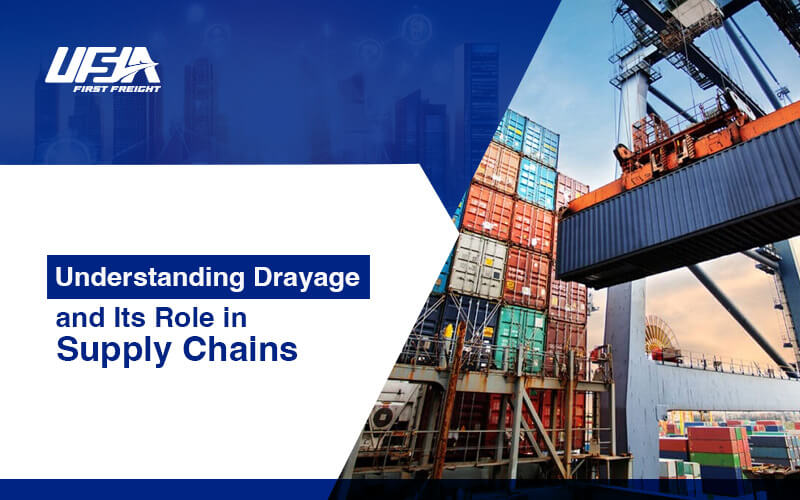In the complex world of global commerce, every piece of the supply chain puzzle matters. There’s one crucial piece that often flies under the radar, and that is drayage. Whether you’re shipping as a business owner or are just interested in how goods get moved around the world, understanding drayage can help you understand an important piece of the puzzle in modern logistics. Let’s dig into this essential service that keeps global trade moving smoothly. Drayage and Its Role in Supply Chains
What is Drayage?
Think of drayage as the short-distance sprint in a long-distance relay race. Essentially, what is drayage? It is a specialized transportation service that undertakes the movement of shipping containers and goods over short distances, usually between ports, railyards, and nearby warehouses. Even though the connectors it gives rise to may seem like a minor part of the journey, they can create very extensive major transportation gaps in the supply chain.
Key Role of Drayage in Supply Chain
Drayage carries out several roles in the supply chain. Each of them will require proper timing and coordination to ensure it works well without expensive delays in the supply chain. These roles are:
- Port Operations: Transporting containers directly from ships onto storage yards or into trucks. This is the first-mile service that keeps ports free and ensures that cargo keeps moving.
- Rail Terminal Management: The movement of containers from rail cars to trucks and vice versa, maintaining non-disruptive changes in transportation modes.
- Warehouse Distribution: For example, delivering containers to distribution centers or warehouses to enable inventory management and the processing of orders.
- Cross-Docking: Aiding the immediate transshipment of goods between vehicles in order to get products off trucks onto additional trucks sooner by reducing time spent on storage and thereby speeding up deliveries.
- Container Yard Operations: Managing empty container logistics and repositioning containers as needed for optimal efficiency.
What are Intermodal Drayage Services?
An intermodal drayage is a specialized form of container movement that connects different types of transportation. It tries to bridge the gap between ships, trains, and trucks, ensuring cargo moves from one mode of transportation to another without too much hassle. This particular service is very important to businesses that make use of multiple shipping modes to efficiently and cost-effectively move their goods.
How Intermodal Drayage Works?
Now you know what is drayage in Intermodal transport but how does it work? Let’s understand how the intermodal drayage process follows a systematic flow:
- Ocean vessels arrive at ports carrying containers
- Drayage trucks collect specific containers from the port
- Containers are transported to rail terminals or distribution centers
- Documentation and customs clearance processes are completed
- Cargo continues its journey via the next mode of transportation
This process requires careful coordination between shipping lines, terminal operators, drayage companies, and rail carriers to ensure smooth transitions.
What are the Benefits?
Drayage offers a range of benefits by combining different transportation modes. This approach helps businesses reduce costs, improve flexibility, and enhance the security of their shipments.
- Cost Efficiency: It reduces warehousing costs and minimizes storage fees at ports and terminals. It enables consolidation of shipments for better rates and reduces overall transportation expenses while changing intermodal modes of transport.
- Security Improvement: Intermodal drayage reduces handling points and transfers risks while providing continuous shipment tracking. It also minimizes any potential cargo damage and ensures proper container handling.
- Improved Supply Chain Flexibility: It allows response to quick shipping schedule changes and options for route modifications. It also enables easy adaptation to volume fluctuations.
- Time Efficient: It speeds up port clearance container movement and reduces transit time between different modes of intermodal transport.
- Better Inventory Management: Intermodal drayage supports just-in-time inventory strategies and reduces the need for large storage facilities. It also enables better stock level control and facilitates cross-docking operations.
- Professional Expertise: Drayage at port allows access to experienced drivers with a knowledge of local routes and regulations. They understand the custom and documentation process, thus reducing overall transit time.
Common Challenges in Operations
Drayage operations face several challenges that can disrupt the efficient movement of goods. From port congestion to driver shortages, these obstacles can lead to delays and increased costs for businesses.
- Port Congestion: Port congestion may arise from an increased number of vessels and containers. It leads to delayed and increased service costs for businesses.
- Driver Availability: Qualified driver shortages have been an issue in the service reliability and capacity of the industry. The industry is still not able to attract and retain expert drivers.
- Poor Equipment Management: Unavailability of necessary chassis and containers in various locations. It also encompasses issues of chassis/container shortages and equipment maintenance issues.
- Schedule Complexity: Coordinate numerous parties and have strict time windows. Ineffective coordination may result in appointment cancellations and late deliveries.
- Documentation Requirements: Dealing with large volumes of documentation as well as compliance requirements. Documentation errors or omissions may cause a huge delay.
Conclusion
Drayage may seem simple, but it profoundly impacts the supply chain. With global trade becoming an increasingly important phenomenon, logistic company in USA and further afield need efficient drayage operations to cope with those needs.
Understanding what is drayage goes a long way to helping you make informed shipping decisions, thus ensuring smooth operations and avoiding costly delays. The future of drayage depends upon new technologies and the challenges that are faced in coping with the evolving demands of global commerce.
Staying informed about the best practices in a business is a method that can make an undertaking competitive in the current market.
